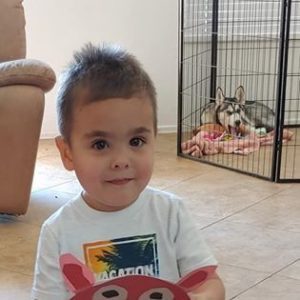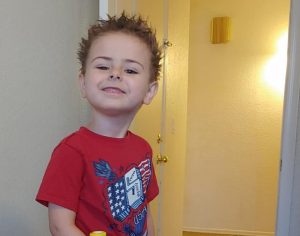- Slug: BC-CNS COVID Special Ed, 1,090 words.
- 2 photos and captions below.
By Endia Fontanez
Cronkite News
PHOENIX – Many Arizona schools stuck with virtual instruction this fall as the COVID-19 pandemic persists, but for the 148,000 children who take part in special education programs, the new online environment can be a particular challenge.
When school started back in August, June Krafft was busy at home running from room to room, making sure her two young sons kept focused on their schoolwork.
James, 3, and Christopher, 5, both attend Kingswood Elementary School in Surprise, in the preschool and kindergarten programs.
The brothers, Krafft said, are on the autism spectrum. Christopher also has attention deficit hyperactivity disorder and has been taking medication for it since he was 4.
Before COVID-19 was declared a pandemic in March, a specialist came to Krafft’s home for about 40 hours a week.
Krafft recalled the difficulty she had explaining the implications of the pandemic to the boys.
“At first I just told them, ‘There’s this big sickness out there, and we don’t want you to get it. And so you have to stay home from school until it gets better, and then we can send you back,’” she said. “At first it was just a couple days. And then it was a week, and then it was a couple of weeks. And now, we’re here.”
Gov. Doug Ducey signed an executive order in July requiring that schools reopen at least in a limited capacity for students who have no place to go during the day or need a free lunch and for those with certain disabilities who have an Individualized Education Program, or IEP.
IEPs are available for students with intellectual disabilities or conditions including hearing or visual impairments, dyslexia, autism and speech or language disorders.
The pandemic does not mean that schools can simply stop providing necessary services to students with IEPs, and these services should be offered either virtually or in-person with sufficient safety measures in place, according to Amanda Glass, staff attorney at the Arizona Center for Disability Law.
If a school fails to provide services for a period of time, that must be made up as “compensatory education” at a later date.
In Arizona, Hispanic children make up the greatest percentage of special education students – about 46% of the 148,000 – followed by white children at about 37%, according to the state Department of Education.
Kareem Neal is a special education teacher at Maryvale High School, in the Phoenix Union High School District. He has been at Maryvale for the past 13 years and was named Arizona’s Teacher of the Year for 2019.
Neal said he has 15 students on his caseload, all of whom are learning virtually this semester.
The most difficult part of teaching special education online, he said, is that it has become much harder to give each student individual attention while still keeping the others engaged.
“In person, I have three paraprofessionals that work in my classroom, and the way my class is shaped, I put the desks kind of like a horseshoe,” he said. “Virtually, I am still having read-alongs and asking individuals questions and things like that. But I can’t see them all at once, and I can’t get to them all so easily.”
Despite the challenges, Neal said he “would not feel great” about returning to a fully in-person learning environment.
“Selfishly, yeah, I would like to go back. I’m a relatively healthy person, so I’m probably not feeling as worried about catching COVID myself as I would be for my mom or some of my students,” Neal said. “But the tricky part is (if) my students came back and one of them caught it and something happened to them, I don’t think I would be able to survive that. I would have a hard time continuing on if something like that happened.”
Glass said some schools have been requiring parents to sign a COVID-19 liability waiver before sending students back to campus to receive special education services.
“It’s bizarre,” she said, “because schools don’t ask parents to sign waivers about getting the flu or getting lice or getting hurt on the playground. … It’s just something concerning, and I’m not sure about the legality of it.”
James and Christopher are Krafft’s biological grandchildren, but Krafft, 57, adopted them at birth and is raising them on her own. A former computer engineer, she now focuses on taking care of the boys, both of whom were born drug-addicted.
Krafft, who has a degenerative disease in her back as well as an immune disorder, has received assistance from the Arizona Department of Economic Security through its early childhood autism program.
Once the pandemic hit, the boys required a lot of help logging into their virtual classrooms. Krafft originally tried putting them at computers next to one another in her home office but realized that wouldn’t work with both of their teachers talking at the same time, so she moved Christopher to the kitchen table.
With James, she said, “(I) quickly learned that keeping a 3 year old on the computer for any length of time was ridiculous.” So she put him in a high chair and tried to keep him busy with crayons and paper.
Nevertheless, “By about 9:30 (in the morning), the kids were just done.”
Christopher had an especially hard time adjusting.
“He started getting a little antsy about what happened to school, why I’m not seeing my teacher and my friends. He became very upset about it,” Krafft said. “And then he just became a homebody. He didn’t want to leave the house at all. Basically, if he couldn’t go to school, he didn’t want to go anywhere.”
After a recent T-ball game that Krafft was able to schedule for Christopher, she said she realized the importance of letting the boys interact with other kids.
“I knew then, when I saw him smile for like the first time in six months … that they have to go back.”
Last month, both kids returned to in-person learning at Kingswood.
Krafft said she has concerns about their safety and her own, given her health challenges, but she has to put the needs of her children first. For them, she said, the benefits outweigh the costs.
“I’ve gone back and forth on it, but I look at these children and I think to myself, ‘Six months of no interaction with other children, and they are so depressed.’”
Now, she said, the boys are doing far better.
“They love getting on the bus. They love going to school. They love their teachers,” she said. “They’re just jumping for joy.”
For more stories from Cronkite News, visit cronkitenews.azpbs.org.
^_=

